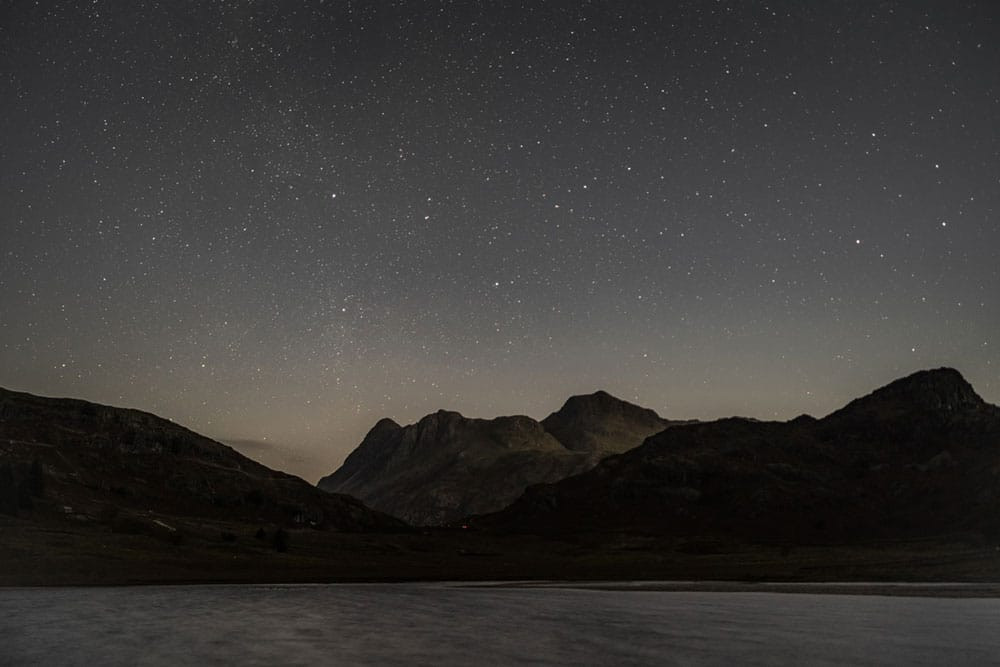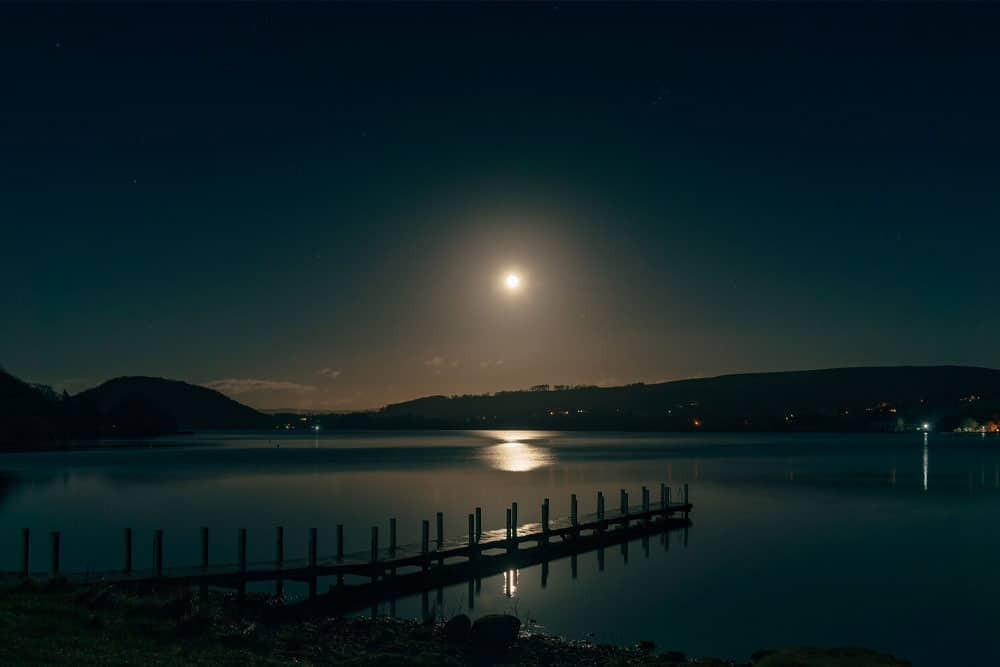By the light of a full moon
Disturb the water’s still and silver surface and dive into a glassy mirror, reflecting the mountains, moon and stars. A full moon swim in Ullswater lake urges us all to give in to a little lunacy…

The Moon, how definite its orb!
Yet gaze again, and with a steady gaze—
‘Tis there indeed, but where is it not?—
Full moon swim
(Poem ‘The Moon, how definite its orb’ by Samuel Taylor Coleridge)
When the moon rises over Ullswater on a clear, calm night, you might catch its twin shimmering in the lake. At its brightest and fullest, the moon lights up the fellside, casting sharp-edged shadows. For some, it’s the perfect time for a full moon swim.
Guided by cold water swim specialist, Colin Hill, you will have light-up tow floats and glow sticks to find your way. suitable for all abilities of swimmer. A magical experience which wont be forgotten.
From the Latin lunaticus, meaning ‘moonstruck’, ‘lunacy’ once meant an intermittent insanity directly related to phases of the moon. So, perhaps it’s a joyful form of lunacy that compels some swimmers to step out by night and take to the cool, dark water; to chase the moon’s reflection and untether from the day. The last of the dusk chorus, an intake of breath, cool ripples on the skin. The lake at night is another world.
Full moon night swims
2025
5 October – Blood Moon
7 December – Cold Moon
2026
3 January - Wolf Moon
1 February - Snow Moon
3 March - Worm Moon
1 April - Pink Moon
1 May - Flower Moon
31 May - Blue Moon
29 June - Strawberry Moon
29 July - Buck Moon
27 August - Sturgeon Moon
26 September - Harvest Moon
25 October - Hunter's Moon
24 November - Beaver Moon
23 December - Cold Moon
It is suffused o’er all the sapphire Heaven,
Trees, herbage, snake-like stream, unwrinkled Lake,
Whose very murmur does of it partake…
Moon music
There’s a full moon risin’… Neil Young. Listen to our full moon playlist on Spotify.

Waxing and waning
It takes 29.5 days for the moon to loop the earth. Half lit by the sun; when the moon is full, we see its bright side. When it’s new, it’s invisible because the sunlit side faces away from us. From new to full and back again, the moon moves through eight phases:
new moon
waxing crescent moon
first quarter moon
waxing gibbous moon
full moon
waning gibbous moon
last quarter moon
waning crescent moon
Our comings and goings have always run to a cosmic schedule, and lunar calendars observing the changes date back as far as 25,000 BCE. From one full moon to the next, as the moon wanes and then waxes again, each month has on average one full moon (the word ‘month’ actually comes from moon).
Originally defined as either 29 or 30 days – in line with the 29.5-day lunar cycle – some of our calendar months were later given extra days so that 12 months would make up one full 365-day solar year. But because of these extra days, and the fact it only takes the moon around 354 days to complete its full 12 cycles in a year, once every two and a half years or so, we get 13 full moons in a year – or two in one calendar month. This is known as a Blue Moon.

Naturally naming
Markers of change, full moons are natural carriers of signs and stories. The year’s full moons go by different names – their arrival in the sky tied to patterns on earth. Different cultures have given their own names to full moons over time, but many of the most used come from native American culture. You can look up at the ‘Wolf Moon’ in January, named for howling wolves that have gone hungry over winter, or the ‘Pink Moon’ in April, named for a spring-blooming wildflower. The north American strawberry harvest lends June its ‘Strawberry Moon’ name, and in September you’ll see Neil Young’s ‘Harvest Moon’ – or the ‘Full Corn Moon’ in the sky. Closest to the Autumn equinox, September’s full moon shines particularly bright and rises particularly early. The crops are ripe and ready to gather, and its light lets the farmers work late.
If a full moon coincides with the moment in the moon’s elliptical orbit when it’s closest to earth, we see a super moon – such as this April’s super ‘Pink Moon’ – even brighter and even bigger in the sky than usual (weather permitting…)
And low and close the broad smooth mountain
Is more a thing of Heaven than when
Distinct by one dim shade and yet undivided from the universal cloud
In which it towers, finite in height.
When the moon is full, sun and moon are aligned either side of Earth, and the gravitational pull of the moon on the planet means ocean tides are high. In ancient cultures full moons, and the myths that came with them, symbolised ripeness, wholeness and fertility. The moon “replenishes the earth”, wrote Roman naturalist Pliny the Elder, “when she approaches it, she fills all bodies, while, when she recedes, she empties them”.
Moisture rich
Perhaps that’s why, in the wake of centuries of moon-gazing, many growers and farmers still swear by lunar planting, which works on the principle that just as the moon creates tides, so it affects moisture in the soil. According to traditional farmers’ almanacs, crops and flowers that grow beneath the soil should be planted on a full moon, while plants that flourish above the ground should be sown when it’s new.
For all we know about the science of axes and orbits, the full moon can still cast her spell. When the upper curve of the moon first touches the horizon, we call it moonrise. Perfectly in sync with high tide, a full moon will always rise just after sunset, 50 minutes later each day.
And, as the sun changes hands with the moon, that’s when you’ll find us every month – pushing out into the lake’s surface, for a full moon swim.

Following the sky’s timetable, book online to join our open water swimming specialist, Colin Hill, for a full moon swim in the lake.